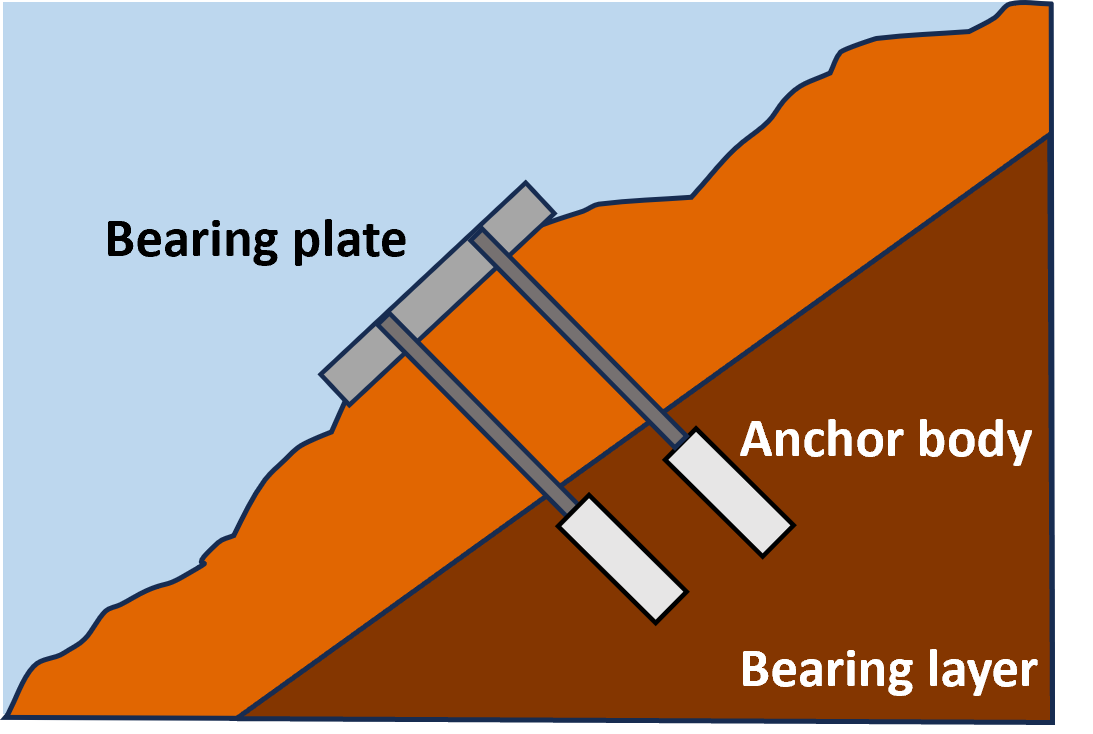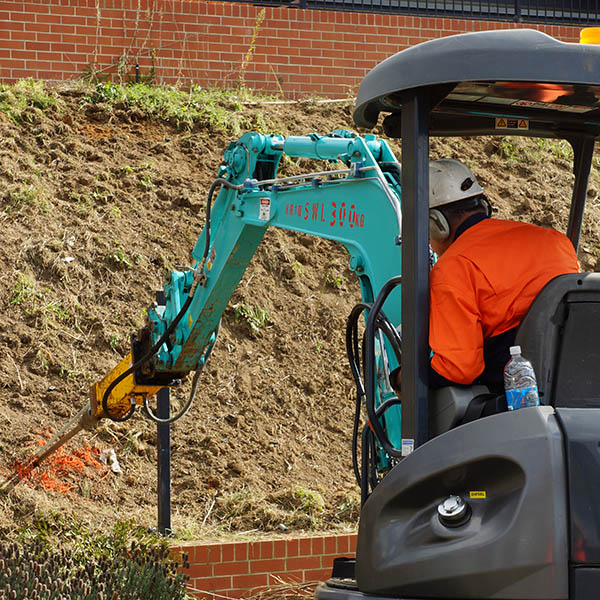Contractor Tips When Choosing Temporary Structure Reinforcement
Wiki Article
Just How Sturdy Earth Anchors Work: A Comprehensive Guide to Soil Anchoring Solutions
Heavy-duty Earth anchors play an important duty in offering stability and assistance in various building and construction applications. By embedding deeply right into the ground, they withstand upright and lateral pressures efficiently. Various kinds of supports provide to various dirt problems, making them versatile. Comprehending their auto mechanics and installation methods is important for making best use of performance. What variables affect their effectiveness, and exactly how do they compare to typical approaches? The responses may shock you.Recognizing Sturdy Earth Anchors
Sturdy Earth anchors function as essential elements in different building and landscape design jobs, offering stability and support in challenging dirt conditions. These supports function by being embedded right into the ground, where they withstand side and upright forces. Their style permits for protected add-on to structures, guaranteeing they stay anchored versus dirt motion or external loads.The performance of heavy-duty Earth anchors mostly depends upon the kind of dirt and the anchor's setup deepness. Proper installation strategies are critical, as they establish the anchor's holding ability. Environmental aspects, such as wetness and freeze-thaw cycles, can likewise impact performance.These anchors are frequently used in applications ranging from protecting fencings and retaining walls to supporting short-term structures throughout negative weather. Recognizing the concepts behind sturdy Earth supports is vital for experts seeking to boost the durability and safety of their projects.Kinds Of Heavy-Duty Earth Anchors
Various kinds of heavy-duty Earth supports are created to fulfill specific requirements based on dirt problems and project requirements. Helical supports, featuring screw-like blades, are reliable in softer soils, offering high lots abilities and easy setup. Driven anchors, which are inculcated the ground, are ideal for rocky terrains and offer prompt lots support. Tie-back anchors are typically made use of in preserving wall surface applications, permitting lateral support by securing into the ground at an angle. One more kind is the cast-in-place support, ideal for concrete applications, as they are integrated into foundations for boosted security. Dirt screw anchors are functional options that can be utilized in various dirt kinds, supplying dependable tension and compression capabilities. Each type serves distinct applications, making certain security and safety in construction and landscape design tasks. Comprehending these alternatives enables educated choices in choosing the suitable Earth securing solution.The Mechanics of Dirt Anchoring

Comprehending the auto mechanics of dirt anchoring requires an evaluation of numerous sorts of Earth anchors and their setup techniques. Each support type offers unique attributes that affect its efficiency in various soil problems. Proper installation approaches are vital for making the most of the securing system's security and performance.
Kinds of Earth Anchors
Earth anchors, vital parts in dirt anchoring systems, can be found in a number of types, each designed for particular applications and dirt problems. The most usual types consist of screw anchors, which are turned right into the ground, providing solid side resistance. Helical supports include blades that enable reliable installation in numerous dirt kinds, making them suitable for both permanent and short-term applications. Driven supports, typically made from steel, are inculcated the dirt and are reliable in thick or rocky settings. Auger anchors make use of a helical layout to help with setup in softer soils. Finally, plate supports are composed of a flat plate buried horizontally, distributing tons over a larger area, ideal for applications needing high load capacities in natural dirts.Setup Strategies Discussed
Appropriate installment techniques are important for the effectiveness of soil anchoring systems. The procedure typically starts with website analysis, confirming the chosen area can sustain the anchor's lots. After identifying the right anchor type, correct opening deepness and angle must be developed. The setup entails driving the support into the ground using specialized devices, such as hydraulic or hands-on motorists, to achieve ideal embedment. Post-installation, tensioning the support is critical to ensure stability; this is often verified with load testing. In addition, bordering dirt problems need to be monitored to avoid variation. Complying with these strategies not just improves the support's efficiency yet also lengthens its life expectancy, giving reputable support for different applications.Applications of Heavy-Duty Earth Anchors
While heavy-duty Earth anchors are usually related to building and landscape design, their convenience reaches a selection of applications throughout different industries. In civil engineering, they give important support for keeping wall surfaces, ensuring security in locations vulnerable to dirt disintegration. The marine sector makes use of these supports for protecting anchors and marinas, preventing movement caused by currents and tides. Additionally, in the useful link telecom sector, heavy-duty Earth supports are substantial for stabilizing cell towers and various other tall frameworks versus wind forces. Agricultural applications likewise profit, as these anchors can protect frameworks like greenhouses and livestock secure fencing, guaranteeing they endure harsh weather. Furthermore, in renewable resource tasks, such as wind ranches, Earth Extra resources supports play a vital function in securing wind turbine structures, boosting general safety and performance. This wide variety of applications highlights the flexibility and integrity of durable Earth supports across numerous areas.Advantages Over Traditional Anchoring Methods
Although conventional anchoring approaches have long been depended upon for stability, heavy-duty Earth anchors use substantial advantages that improve performance and effectiveness. One significant advantage is their superior load-bearing capability, which allows them to stand up to higher forces without failing. This toughness makes them suitable for demanding applications, such as in building and construction and utility installations.Additionally, heavy-duty Earth supports are made for deeper setup, giving greater security in numerous dirt conditions, including loosened or sandy dirts. Their resistance to rust and environmental variables assures a longer life expectancy and reduced maintenance expenses compared to standard methods.Moreover, these supports can be mounted with marginal disturbance to the surrounding location, preserving the integrity of the landscape. Generally, durable Earth supports present a efficient and reliable remedy for anchoring needs, exceeding the restrictions often connected with conventional anchoring strategies.Setup Refine and Best Practices
The setup procedure for soil securing options starts with complete prep work and website evaluation to guarantee peak efficiency. Following this, a detailed installment overview supplies clear directions for effective execution (Manta Ray anchors). Sticking to these finest methods is this post important for accomplishing reputable and lasting anchoring resultsPreparation and Site Analysis
Efficient prep work and thorough site examination are crucial steps in the installation of dirt securing services. Prior to installation, the soil kind need to be analyzed to identify its bearing ability and suitability for anchoring. Carrying out a geotechnical study can give vital information regarding dirt make-up, dampness levels, and prospective ground activity. In addition, recognizing existing frameworks, plant life, and energies is necessary to avoid disturbance throughout installation. The location needs to be free from particles and barriers to ensure risk-free access for devices. Climate conditions must also be kept an eye on, as unfavorable conditions can impact both safety and installment efficacy. By meticulously preparing the website and examining all appropriate variables, the probability of effective anchor performance is considerably raised.Step-by-Step Setup Guide
A detailed installment procedure is vital for accomplishing suitable performance of soil anchoring services. The setup starts with picking the suitable support type and ensuring the site is clear of debris. Next off, appropriate hole positioning is established based upon lots requirements. As soon as the place is developed, holes are drilled to the defined deepness and size making use of the correct tools. The support is after that placed into the hole, ensuring it is straightened properly. After securing the support, soil is backfilled and compressed to enhance security. It is important to adhere to producer standards throughout the process. A post-installation assessment confirms that the anchors are properly positioned and functioning as planned, supplying trustworthy assistance for the desired application.
Upkeep and Examination of Earth Anchors
Normal upkeep and evaluation of Earth supports are crucial for ensuring long-lasting efficiency and stability. Periodic checks enable for the very early discovery of concerns such as deterioration, loosening, or soil movement. Assessors should search for indicators of corrosion or destruction on the anchor parts, particularly at the link factors. In addition, the surrounding dirt ought to be evaluated for erosion or adjustments in dampness web content, which can impact anchor effectiveness.It is recommended to develop a regular examination routine, ideally at the very least yearly, depending on environmental problems. During examinations, all visible components should be cleaned to eliminate dirt or particles that can conceal possible troubles. Any kind of indicators of distress, such as tilting structures or unusual settling, must trigger immediate analysis. Appropriate paperwork of inspections can aid in tracking support performance with time and help with timely upkeep actions, making sure the anchors remain trusted and useful.Regularly Asked Concerns
What Materials Are Heavy-Duty Earth Anchors Commonly Made From?
Sturdy Earth supports are generally built from durable products such as galvanized steel or stainless steel, ensuring strength and resistance to deterioration. These products offer durable support and stability in various soil conditions and applications.How Do Soil Problems Affect Anchor Efficiency?
Dirt conditions substantially affect anchor efficiency. Variables such as dirt type, wetness material, and compaction affect the anchor's grasp and security, with natural dirts typically supplying far better resistance than loosened or sandy dirts, impacting total performance.
Can Heavy-Duty Earth Anchors Be Recycled After Elimination?
Heavy-duty Earth supports can be recycled after removal, provided they are examined for damage and wear. Correct cleansing and maintenance boost their durability, guaranteeing reliable performance in subsequent setups when conditions permit for secure reinstallation.What Are the Ecological Influences of Using Earth Anchors?
The ecological influences of utilizing Earth anchors consist of possible soil disturbance, disruption of neighborhood ecological communities, and possible contamination of groundwater. If made use of responsibly, their benefits frequently outweigh these worries, promoting stability in various applications.Just how Do I Choose the Right Anchor for My Project?

Report this wiki page